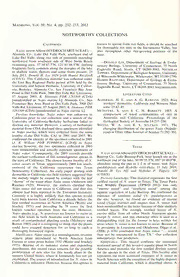
Preview California
Madrono, Vol. 59, No. 4, pp. 232-233, 2012 NOTEWORTHY COLLECTIONS California known to spread from rice fields, it should be searched for thoroughly not only in the Sacramento Valley, but Najas minor Allioni (HYDROCHARITACEAE).— also throughout other rice-growing portions of the Alameda Co., Lake Del Valle Park, southeast end of state. Lake Del Valle, along east side of peninsula extending — northward from southeast side of West Swim Beach Donald Les, Department of Ecology & Evolu- swimming area, 37 34'47.7"N, 121 41'48.5"W, drifting tionary Biology, University of Connecticut, 75 North fragments fairly common along the margins of the lake Eagleville Road, Storrs, CT 06269-3043; Nicholas in shallow water, flowers and some fruits present, 23 TipperY, Department ofBiological Sciences, University July 2011, Donald H. Les 1029 [with Hamid Razifard] of Wisconsin-Whitewater, Whitewater, WI 53190-1790; (CONIV). This California material was collected under Hamid Razifard, Department of Ecology & Evolu- the East Bay Regional Parks permit #596 held by the tionary Biology, University of Connecticut, 75 North University and Jepson Herbaria, University of Califor- Eagleville Road, Storrs, CT 06269-3043. [email protected]. nia, Berkeley. Alameda Co., San Francisco Bay Area Pond in Del Valle Park, 7000 Del Valle Rd, Livermore, Literature Cited 07 August 2003, K. Simmons PDR 1283308 (CDA) [misidentified as Najas marina L]. Alameda Co., San Alderson, H. E. and A. G. Rawlins. 1925. Rice Francisco Bay Area Pond in Del Valle Park, 7000 Del workers' dermatitis. California and Western Med- Valle Rd, Livermore, 07 August 2003, K. Simmons PDR icine 23:42-45. 1283309 (CDA) [misidentified as Najas marina L]. MclNTYRE, S. AND S. C. H. BARRETT. 1985. A Previous knowledge. Najas minor was unknown in comparison of weed communities of rice in California prior to our collection and a search of the Australia and California. Proceedings of the University of CaHfornia-Berkeley herbarium failed to Ecological Society of Austraha 14:237 250. disclose any material. However, a survey of herbarium Wentz, W. A. and R. L. Stuckey. 1971. The CDA material from disclosed three specimens identified changing distribution of the genus Najas (Najada- as Najas marina, which were collected from the same ceae) in Ohio. Ohio Journal of Science 71:292-302. locality (Lake Del Valle, CA) in 2001 and 2003. We confirmed the identity ofthe specimen collected in 2001 PDR {J. R. Willson P199008-C, [CDA]) as Najas marina\ however, the two specimens collected in 2003 Texas were misidentified and actually represent specimens of Najas minor. Consequently, the 2003 records provide Najas minorAllioni (HYDROCHARITACEAE).— the earliest verification of this nonindigenous species in Bastrop Co., Lake Bastrop Park, boat launch site at the the state of California. The closest known locality of A^. northwest end ofthe lake, 30^09'55.3"N, 097 16'49.0"W, minor occurs in Texas, approximately 2400 km south- abundant along the pier in 1-2 m of water, with Najas eastward of the California occurrence (see Texas guadalupensis and Hydrilla verticil/ata, 11 July 2010, Noteworthy Collection). An early paper dealing with Donald H. Les 843 and Nicholas P. Tippery 320 dermatitis in California rice field workers suggested that {CONN). the malady might be caused by contact with the leaf Previous knowledge. This material represents the first "thorns" of the water plant Najas minor (Alderson and verified record of N. minor in Texas. The Texas Parks Rawlins 1925). However, the authors clarified that and Wildlife Department (TPWD 2012) lists only Najas minor did not occur in California, and that this "marine naiad" and "southern naiad" among the We ailment had been reported in the European literature. aquatic vegetation of Lake Bastrop. confirmed the Certainly it is highly unlikely that this species would existence of southern naiad (TV. guadalupensis) at have been known from California a decade before the the site; however, we found no evidence of marine first verified occurrence in North America (Wentz and naiad {Najas marina) and suspect that N. minor had Stuckey 1971) and preceding by 78 years the first been misidentified as the latter because oftheir similarly known voucher specimen from the state. However, toothed leaves. The strongly toothed leaves of N. Najas species (e.g., TV. graminea) are known to occur as marina differ from all other North American species rice field weeds in both Austraha and California as a except A^. nn'nor, and this character often is used as a result of contaminated planting stocks (Mclntyre and distinguishing trait for the former in keys written for Barrett 1985) and it is intriguing to think that the plants areas where TV. minor is not known to occur. Because of could have escaped detection for so long in such a its proximity in Louisiana and Oklahoma, Diggs et al. thoroughly botanized region. (2006; p. 676) concluded that Najas minor "... would Significance. Najas minor is a nonindigenous, invasive thus not be unexpected in East TX." Our collection aquatic plant introduced to North America from substantiates that prediction. Eurasia at some point before 1932 (Wentz and Stuckey Significance. This record confirms the continued 1971). Because of its nuisance status and expanding westward spread of this invasive aquatic plant in North distribution, this record raises concern for the possible America and provides the first verified floristic record proliferation of new sites for this weedy plant in the for the species in the state of Texas. This locality also western United States, where it fortunately has not yet represents the most westward extension of TV. minor in established. The source of introduction for A^. minor in North America with the exception ofthe highly disjunct A California is unknown. However, because this species is material from California, which is described above.
